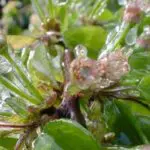How do you choose fruit trees that will work for your landscape? This article and video show you the tips Read more
Dual Cropping: Growing Hazelnuts and Truffles

Some things go really well together, like pancakes and maple syrup. But there are other winning combinations that few people know about. One of them is growing hazelnut trees (Corylus) together with truffles.
Truffles are a highly sought after edible fungi. They are hard to find, they don't stay fresh for long, and they are incredibly expensive to buy. They grow underground, attaching themselves to the roots of certain types of trees including hazel, oak and beech.
Teaming up benefits both the truffles and the trees. The truffles help tree roots access water and nutrients in the soil. In exchange, the fungi take in the sugary juices that those tree roots exude.
In 2019, Adam Koziol of Earthgen Tree Nursery was a guest on The Urban Forestry Radio Show and Podcast when he was launching a series of truffle-inoculated hazelnut trees for sale from his nursery.
The idea was that growers would have two crops in one. Hazelnut trees can earn up to $3000 per acre - and truffles? They can be sold for hundreds of dollars a pound.
Scientists continue to study the most effective ways to inoculate hazelnut trees with truffle spores, but in the meantime, growers who have invested in Earthgen's truffle-inoculated hazelnut trees will have to wait and see. It can take 6 to 10 years until both crops will be mature enough to harvest.
Read the interview below to learn more about growing hazelnut trees or shrubs together with truffles. For additional information, listen to the entire hour-long podcast, or watch the video version of the show. This interview was slightly edited for clarity.

GROWING HAZELNUT TREES AND TRUFFLES TOGETHER
How did your hazelnut tree/truffle project get started?
AK: We started off with an experiment. We secured inoculum in Spain and we attached it to certain trees like hazelnuts and English oaks.
First, we followed a strict protocol that the scientists required. We had special growing media produced for us that was made out of sterilized pine bark and peat moss. We didn't want any mushroom spores of any other type interfering with our experiment.
After some time, we put the roots underneath the microscope and then there are certain things that you look for. Now, let me state that the truffle industry is very secretive. So, there's no information out there. So, whatever you pick up, you kind of keep under your hat.
So, we went on tours in Spain and then you see pictures of what truffle mycorrhizae (fungus that grows in a symbiotic relationship with plant roots) look like. So you bring the information back and you compare it with what we had. And on analyzing our data, we said, yeah, they're here. That’s good.
Fruit Trees
That Thrive

What kind of truffle inoculant are you using on your hazelnut trees and shrubs?
AK: The truffle we're working on is a burgundy truffle. So, their season could be from August to the end of November or early December. While we sell truffle inoculated plants, we will soon be able to inoculate an existing orchard as well.
Is the idea that farmers will be able to grow and sell hazelnuts and truffles in the same field?
AK: Exactly. Dual cropping is already happening in Spain.

THE HAZELNUT CROP
How are hazelnuts pollinated?
AK: Typically, pollination starts in late May or early April when everything's still frozen here in Ontario. You get a tiny little flower that comes out in the cold weather. And the pollen is dispersed in the wind because there aren’t many pollinators at that time.
Since hazelnuts are wind propagated, how far apart should they be planted from each other?
AK: Ideally, we say the minimum distance would be 10 feet because the hybrid hazelnuts are about 10 to 12 feet tall and they need full sun exposure. You want them far enough apart so you can maximize your distance and get the hazelnuts on the ends of the branches.
How many varieties of hazelnuts do you need for the tree to successfully pollinate and produce fruit?
AK: You need different varieties of hazelnuts to cross-pollinate. Hazelnuts do not self-pollinate so with just one plant you will not get fruit. You need two genetically different varieties. With two plants of the same variety, you will not get successful pollination.

How long will it take until the hazelnut trees start producing nuts?
AK: Our trees produce a massive root system. So, most of the biomass is actually in the roots. Even in our oaks, we had acorns produced the second year. So American hazelnuts start producing the second year. The hybrid hazelnuts produce in the third year. And by the fourth year, you know you're getting quite a few catkins and you can actually harvest a few hazelnuts.

Are hazelnuts shrubs or trees?
AK: You can grow it as a shrub where you've got multiple branches and let it sucker. Or you can decide on your trunk and grow it as a tree by pruning off all the shoots except one which will be the trunk. And then, once it’s grown to the height that you want it, you can let it branch out.
I like telling people the first year or maybe even to the second year, let your plant grow normally so it photosynthesizes. And most of the energy will go into the roots, because the secret is a strong root system. And then you'll never really have to worry about its health or vigour. So that's so critical. A lot of people think, well, we want to get that height. But if the there are no roots to it, you know you get bad weather conditions, your plant will die.
How are hazelnut trees propagated? What is the difference between tissue culture propagation, layering, or grafting?
AK: Tissue cultures are produced in the lab. They take a sliver of the plant tissue and they root it out in something like a petri dish. And then they grow out, they get the roots. Then they send it out to the nursery and then the nursery can either grow it out in containers or they grow it out as a bare root. It depends on what the systems they have.
For layered propagation, you take a branch and for the simplest type of layering you could put it in the ground. And then it produces new roots where the ground is. And then you cut it off of the the original plant. So basically, you're bending your branch over, you're burying it and then it will grow a whole new plant. And it'll take about two years to get it to root out. This is an inexpensive way to propagate a plant but it's hard for mass production.
About grafted hazelnuts: I've been trying it, but let's say you graft an American variety with a European on top. Hazelnuts tend to sucker a lot. So, then you get all these suckers out here. And sometimes the stem that comes out is a lot nicer looking. So, then somebody comes along and cuts off the grafted part and you’re back to the original variety.

Are there many hazelnut cultivars?
AK: Well, there are quite a few. Here in Canada, we want to have plants that can withstand the climate. The native hazelnut can do that. And a native hazelnut doesn't get Eastern filbert blight (EFB) while the European hazelnuts are vulnerable to that blight. So, there are some crosses that put the qualities of an American hazelnut but the flavours of the European hazelnut. Because the European varieties are the ones that taste the best.
At Earthgen, we sell 10 different varieties but there are many more out there. We tried so many in the last 10 years. One of the popular varieties called Barcelona did get the blight frequently. So, the University of Oregon came out and invented a lot of new varieties. And they're coming out with new ones all the time, as well. Even Rutgers is working on their varieties from the East Coast. When we identify the best varieties, we will start cloning them.

Can hazelnut trees grow in hot climates like Florida?
AK: While hazelnuts like full sun, they need a cold winter.
THE TRUFFLE CROP
Where do truffles grow in the wild?
AK: They grow on hazelnuts. It's very common in Europe. They grow on oak trees. Pine trees are another good one as well, I should say. And then we might even get them on birch and beech trees and certain other oak trees as well.
Why have you chosen an inoculant for a burgundy truffle?
AK: In our climate we can harvest the burgundy truffle throughout the October and November and maybe early December. The black truffle wouldn’t work in Canada because the season goes from mid-November to mid-March when the soil would be frozen in our climate so you can’t dig them out. The cream of the crop is the Italian white truffle, but it doesn’t grow in our cold climate. It's very specialized to a certain region in Italy.

How do you unearth the truffles?
AK: You will need a dog or a very strong nose. And you're going to get right down to the ground and a dog will tell you where it is. So, you'll dig a little hole and find a truffle. They usually grow about two to eight inches below the surface. But the surface of the ground should be soft. That's one of the key ingredients. Because if it's heavy clay, you might have a truffle, but it'll be so compact that you will never know that it's there.
Do dogs need to be specially trained to unearth truffles?
AK: We have a scientist have worked on our project last year. He went out with his dog and it's a Border Collie in Simcoe, Ontario. And they found the native truffles in a pine forest. Even if your dog isn’t trained to hunt for truffles, it can be very easily trained. Because the fragrance of the truffle is so distinguishable and strong.

An Exciting Update from August 2021
In August 21, Adam Koziol of EarthGen International Ltd was weeding his hazelnut trees in pots and found his first truffles in one of the pots.
"Finally, three years in the making!" he says.
You can see images of the pot...and the truffles, above.
Fruit Trees
That Thrive


Susan Poizner
Learn more about Susan on the about us page.



